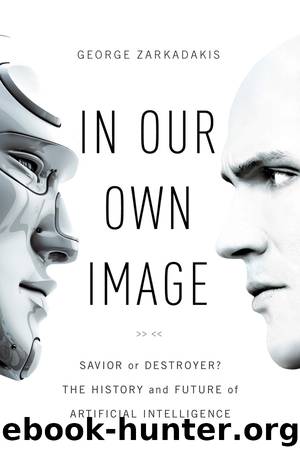In Our Own Image by George Zarkadakis

Author:George Zarkadakis
Language: eng
Format: epub
Publisher: Pegasus
Published: 2016-05-28T16:00:00+00:00
Self-replicating machines
Von Neumann was familiar with Turing’s work. In 1936, he wrote a reference for Turing, supporting his application for a Fellowship at Princeton. The two men had met a year earlier when von Neumann was visiting professor at Cambridge University. By 1939, von Neumann must have read Turing’s work on automata and computing machines,8 for he used his approach to study how cybernetic systems could self-replicate.
Turing had shown how a machine could code any kind of information – a concept he termed a ‘Universal Machine’. Von Neumann realised that, in essence, this meant the Universal Turing Machine could also code itself. Indeed, modern computers, which are Universal Turing Machines, have exactly this ability. All software stored in your computer can be copied to another computer, by your computer. In fact, copying is what takes place whenever you perform any transaction using a computer. When you ‘send’ an email, for example, nothing actually moves from one place to another: an exact copy of your email is reproduced in the computer of the person you want to communicate with. Von Neumann was fascinated with this self-copying property of the Universal Turing Machine. In true cybernetic fashion, he set off to formulate a general theory of self-reproduction that would include living organisms as well as machines. He embarked on this quest with a series of lectures in 1948 – four years before Watson, Crick and Franklin discovered the molecular structure of DNA – and thus answered the puzzle of self-replication in living systems.
Von Neumann applied mathematical logic to show that there exists an automaton that can produce at least two copies of any description of another automaton you feed it with. To prove this theorem, he used a method known as ‘logical substitution’. We will encounter this method again in the next part of the book, when I will discuss logic in more detail and how that Austrian mathematical prodigy, Kurt Gödel, used the method to prove logic’s limits with his infamous ‘Incompleteness Theorem’. As it happened, Turing also used logical substitution in order to prove his theorem on incalculability. Logical substitution is one of these magnificent tricks that mathematicians keep up their sleeves to get them out of trouble. It creates a one-to-one correspondence between two classes of mathematical objects, say between natural numbers and logical signs or operators.9 Thus, the smart mathematician solves an easier problem rather than an impossible one, and becomes famous forevermore.
Using logical substitution, von Neumann substituted bits of information (for example, sets of positions on the infinite tape of a Universal Turing Machine, or a ‘program’ as we would call it today) with whole Turing machines, in order to prove his theorem for self-replicating automata. And here’s the deep insight of this substitution: it confirms, in a most profound way, that artificial life can reproduce in exactly the same way as biological life. Any living system with the ability to replicate can do two things: it can produce and self-replicate. Take genes, for example – they code information for producing proteins but also code for their own self-replication as well.
Download
This site does not store any files on its server. We only index and link to content provided by other sites. Please contact the content providers to delete copyright contents if any and email us, we'll remove relevant links or contents immediately.
Whiskies Galore by Ian Buxton(41834)
Introduction to Aircraft Design (Cambridge Aerospace Series) by John P. Fielding(33055)
Small Unmanned Fixed-wing Aircraft Design by Andrew J. Keane Andras Sobester James P. Scanlan & András Sóbester & James P. Scanlan(32739)
Craft Beer for the Homebrewer by Michael Agnew(18133)
Turbulence by E. J. Noyes(7929)
The Complete Stick Figure Physics Tutorials by Allen Sarah(7301)
Kaplan MCAT General Chemistry Review by Kaplan(6861)
The Thirst by Nesbo Jo(6818)
Bad Blood by John Carreyrou(6531)
Modelling of Convective Heat and Mass Transfer in Rotating Flows by Igor V. Shevchuk(6386)
Learning SQL by Alan Beaulieu(6202)
Weapons of Math Destruction by Cathy O'Neil(6128)
Man-made Catastrophes and Risk Information Concealment by Dmitry Chernov & Didier Sornette(5913)
Digital Minimalism by Cal Newport;(5650)
Life 3.0: Being Human in the Age of Artificial Intelligence by Tegmark Max(5459)
iGen by Jean M. Twenge(5361)
Secrets of Antigravity Propulsion: Tesla, UFOs, and Classified Aerospace Technology by Ph.D. Paul A. Laviolette(5304)
Design of Trajectory Optimization Approach for Space Maneuver Vehicle Skip Entry Problems by Runqi Chai & Al Savvaris & Antonios Tsourdos & Senchun Chai(5001)
Electronic Devices & Circuits by Jacob Millman & Christos C. Halkias(4896)
